Methods in transport geography
Today
15 minute window into statistical methods
Transport geography
Spatial network from the graph theory perspective
Spatial Interaction and Gravity Model
Accessibility
15 minute window into statistical methods
- Regression/Linear Regression
15 minute window into statistical methods
Regression/Linear Regression - describes the strength and character of an association between two or more variables
15 minute window into statistical methods
Regression/Linear Regression
\(Y_i = \beta_0 + \beta_1 X_i + \varepsilon_i\)
Regression assumptions
Linearity - The relationship between X and the mean of Y is linear.
Homoscedasticity - The variance of residual is the same for any value of X.
Independence - Observations are independent of each other
Demonstration
Transport geography: quantitative dimension
- Why transport in this module?
Fundamental for social and economic activities
All about networks & interactions
Transport geography: key elements
Distance
Accessibility: the capacity of a location to be reached by, or to reach different locations
Spatial interaction: movement of people, freight or information between an origin and destination
Transportation and land use models

Source: Rodrigue (2020)
Spatial network from the graph theory perspective
 Source: Wu et al. (2019)
Source: Wu et al. (2019)
Spatial network from the graph theory perspective
Terminology
terminal = node = vertex
link = edge
Sub-graph - Loop (buckle)
More types of graphs
Planar graph vs Non-planar graph
Cycle, circuit
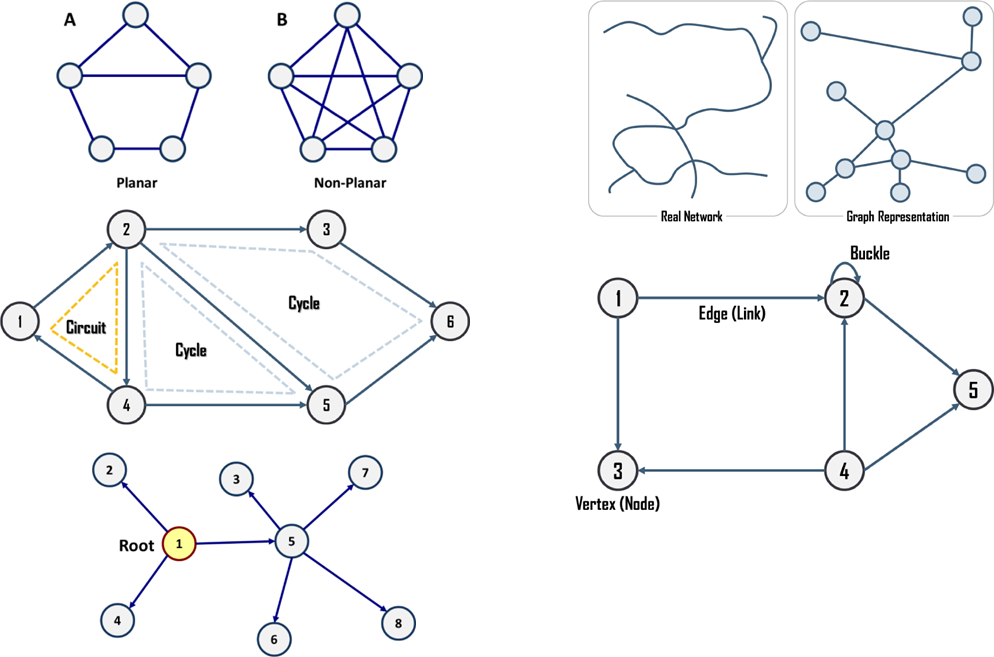 Source: Rodrigue (2020)
Source: Rodrigue (2020)
Plannar graph analysis
Proportion between nodes and edges: \(\beta = e / v\), where \(e\) is the number of links & \(v\) the number of nodes
Network density: \(Gamma\) AKA (number of liks / maximum number of links)
planar: \(\gamma = \frac{e}{3(v-2)}\)
non-planar: \(\gamma = \frac{2e}{v(v-1)}\)
Structure vs Topology
Plannar graph analysis
Degree centrality, Betweenness, Eigenvector centrality,…
Eccentricity: the distance from a given node to the farthest node from it in the network
Shimbel index, or nodal accessibility, or Fareness (see Lecture 3
\(c_𝑖= \sum_j d_{ij}\)
This is a purely topological accessibility metric, remember this for later.
Graph analysis
Closeness centrality (from Lecture 3)
Which node has the shortest distance to other nodes
Instead of focusing on the number of links, the focus turns to the network distances
Different definitions:
Closeness, \(c_{i} = 1/\sum_{j} d_{ij}\)
Fareness, \(c_{i} = \sum_{j} d_{ij}\)
igraphcalculates closeness
Graph analysis
The Gini coefficient
Measure of dispersion often used as Inequality measure
- 0: perfect equality
- 1 :perfect inequality
Ordered X and Y, cumulative percentage
Mostly used for income inequalities, but can be more widely used
\(Gini = A / (A + B)\)
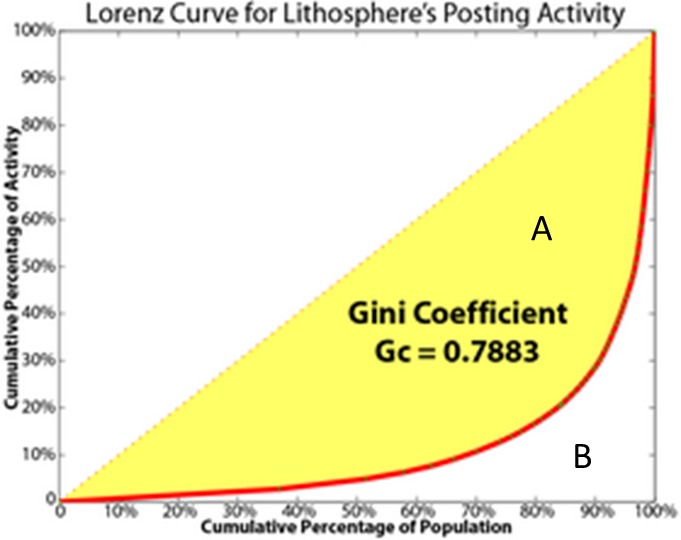
Source: Rodrigue (2020)
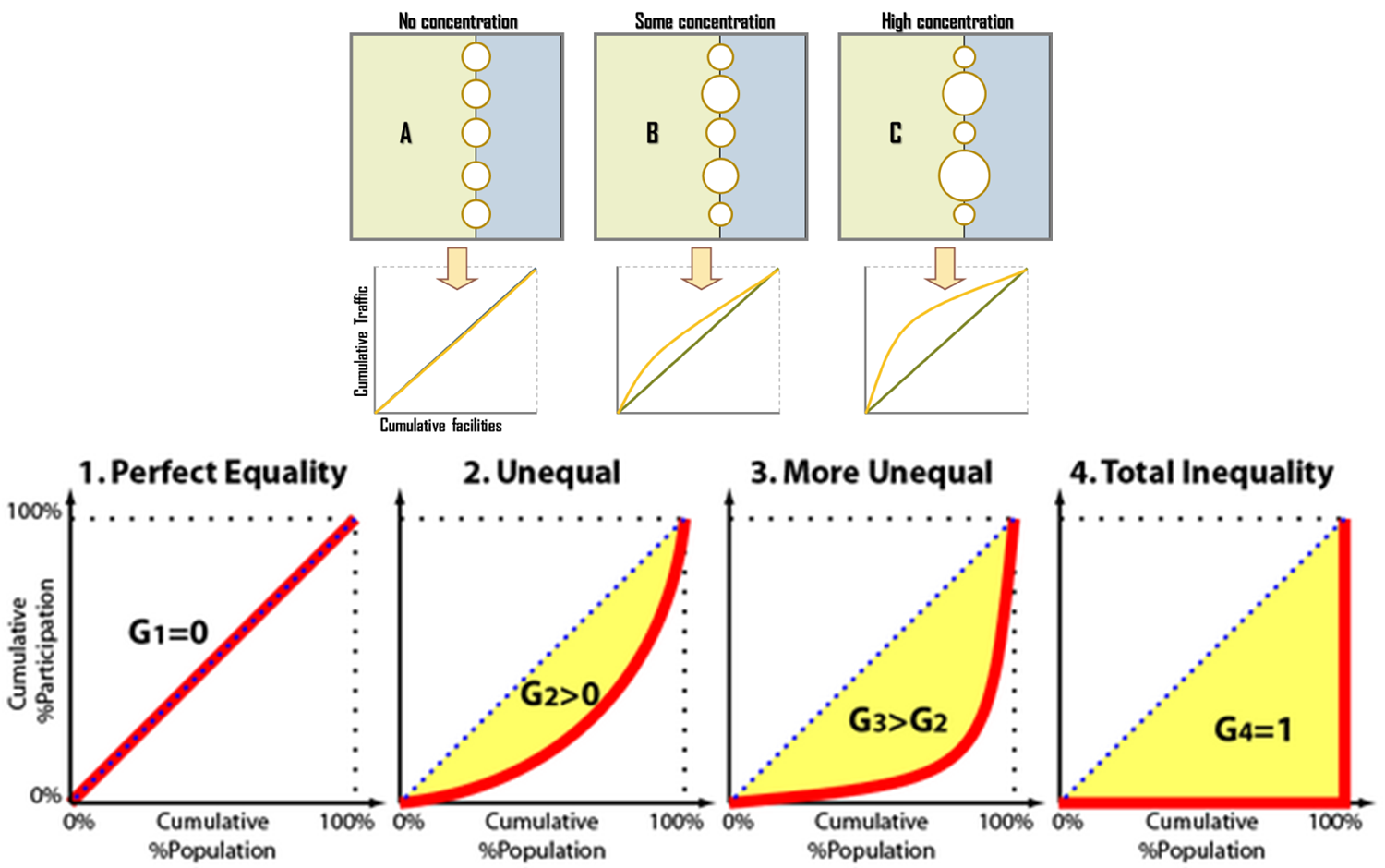 Source: Rodrigue (2020)
Source: Rodrigue (2020)
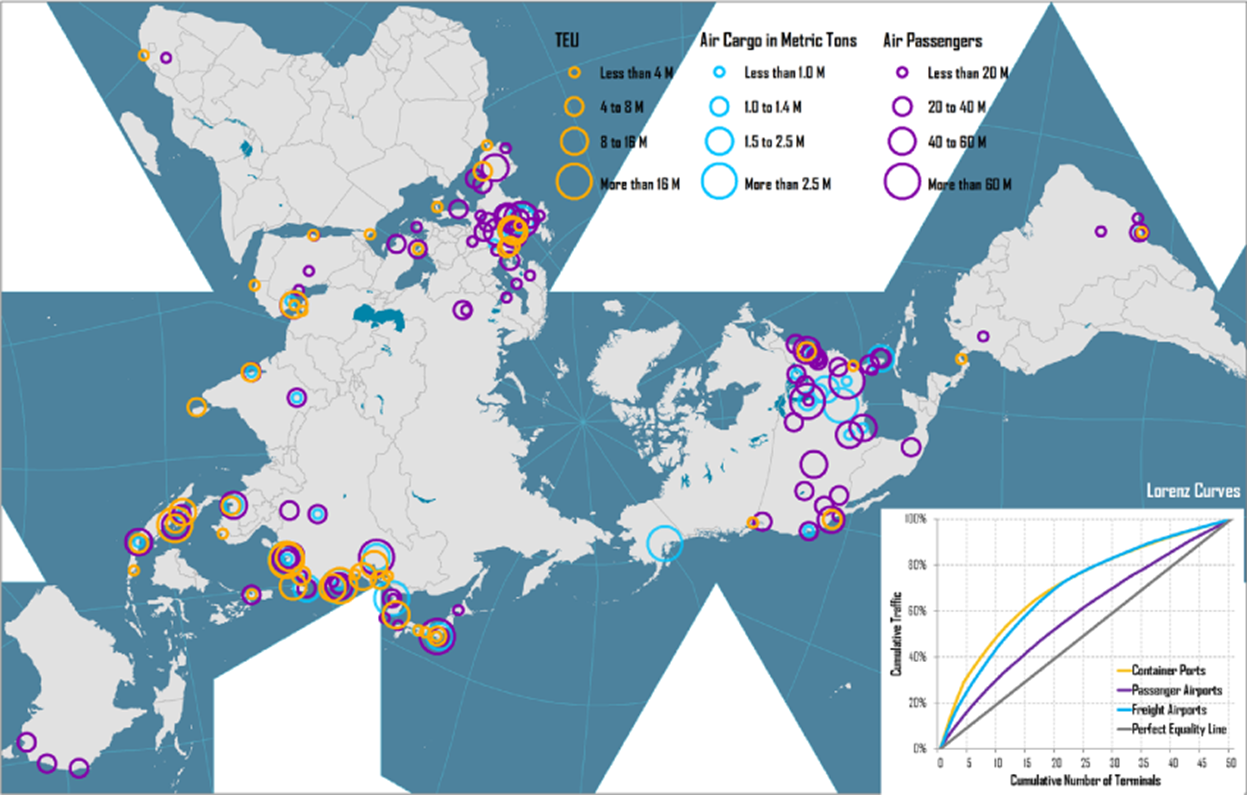 Source: Rodrigue (2020)
Source: Rodrigue (2020)
Example: measuring traffic concentration
Temporal variations of the Gini coefficient reflect changes in the comparative advantages of a location within the transport system
Spatial interactions and the gravity model
A spatial interaction is a realised movement of people, goods or information between an origin and a destination
It is a transport demand/supply relationship expressed over geographical space.
Spatial interactions and the gravity model
Conditions for spatial interaction to be materialised
 Source: Rodrigue (2020)
Source: Rodrigue (2020)
Spatial interactions and the gravity model
Spatial interactions and the gravity model
Gravity model
Analogy of Gravity model
\(Force_{ij} = G \frac{Mass_i Mass_j}{Dist_ij}\)
\(Flow_{ij} = \frac{Attribute_i Attribute_j}{Separation_{ij}}\)
Spatial interactions and the gravity model
\(T_{ij} = f(V_i, W_j, S_{ij})\)
Flows are a function of the attributes of the locations of origin, the attributes of the locations of destination and the friction of distance between the concerned origins and the destinations
\(T_{ij}\): Interaction between location \(i\) (origin) and location \(j\) (destination)
\(V_i\): Attributes of the location of origin \(i\) (e.g. population, number of jobs available, industrial output, GDP); push factors; the potential of origins
Spatial interactions and the gravity model
\(T_{ij} = f(V_i, W_j, S_{ij})\)
\(W_j\): Attributes of the location of destination \(j\), pull factors; attractiveness of destinations
\(S_{ij}\): Attributes of separation between \(i\) and \(j\) (e.g. distance, transport costs, or travel time); cost of overcoming the separation between origins and destinations
Spatial interactions and the gravity model
\(T_{ij} = k\frac{V_i^\lambda W_j^\alpha}{d_{ij}^\beta}\)
\(\beta\): transport friction parameter
\(\lambda\): Potential to generate movements
\(\alpha\): Potential to attract movements
What can we do with this?
1. Calculate flows (naive)
\(T_{ij} = k\frac{V_i^\lambda W_j^\alpha}{d_{ij}^\beta}\)
Known: \(V\), \(W\), and \(d\)
Define: \(\lambda=1\), \(\alpha=1\), \(\beta=2\), and \(k=0.00001\)
These are some standard results from past empirical studies
Big unknown: \(T\)
Example from Tranos, Gheasi, and Nijkamp (2015)
1. Calculate flows (naive)

1. Calculate flows (naive)
Fairly good estimation of reality for such an oversimplified model, but…
… not good enough.
2. Estimate \(\lambda\), \(\alpha\), \(\beta\) and \(k\)
Known: \(T\), \(V\), \(W\), \(d\) and \(k\)
Estiamte: \(\lambda=1\), \(\alpha=1\), and \(\beta=2\)
Why? To understand the effect of distance, pull and push factors
How? Regression
2. Estimate \(\lambda\), \(\alpha\), \(\beta\) and \(k\)
\(T_{ij} = k\frac{V_i^\lambda W_j^\alpha}{d_{ij}^\beta}\)
Look up properties of logarithms, e.g. here
\(T_{ij} = kV_i^\lambda W_j^\alpha d_{ij}^{-\beta}\)
\(ln T_{ij} = ln (kV_i^\lambda W_j^\alpha d_{ij}^{-\beta})\)
\(ln T_{ij} = lnk + lnV_i^\lambda + ln W_j^\alpha + lnd_{ij}^{-\beta}\)
\(\color{red}{ln T_{ij}} = \color{blue}{lnk} + \lambda \color{green}{lnV_i} + \alpha \color{orange}{ln W_j} -\beta \color{purple}{lnd_{ij}}\)
\(\color{red}{y} = \color{blue}{c} + \lambda \color{green}{x_1} + \alpha \color{orange}{x_2} + \beta \color{purple}{x_3}\)
Multivariate linear regression
2. Estimate \(\lambda\), \(\alpha\), \(\beta\) and \(k\)

2. Estimate \(\lambda\), \(\alpha\), \(\beta\) and \(k\)
\(c = lnk = 13.84\)
\(\lambda = lnV_i = 0.727\)
\(\alpha = lnW_j = 0.464\)
\(\beta = lnd_{ij} = -0.624\)
What did we learn?
How can we use these coefficients
3. Estimate accessibility indicators
The potential of opportunities for interaction
Ease of spatial interaction
Attractiveness of a node in a network taking into account the mass of other nodes and the costs to reach those nodes via the network
3. Estimate accessibility indicators
Different typologies (Holl 2007)
Network access
distance to access the network
travel opportunities
Travel cost measures
- network access + distance/time travelled on the network
Market potential accessibility
- destinations at greater distance provide diminishing opportunities
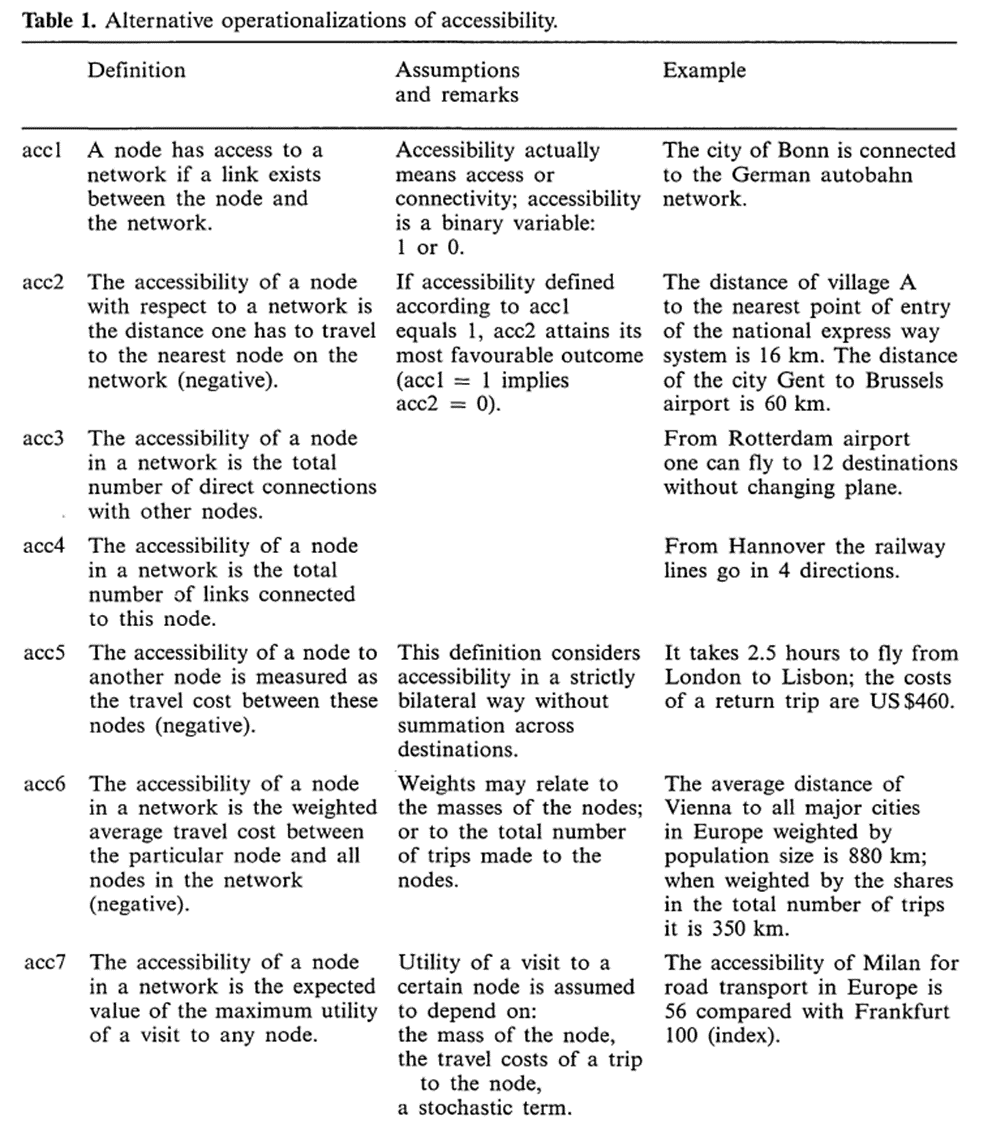
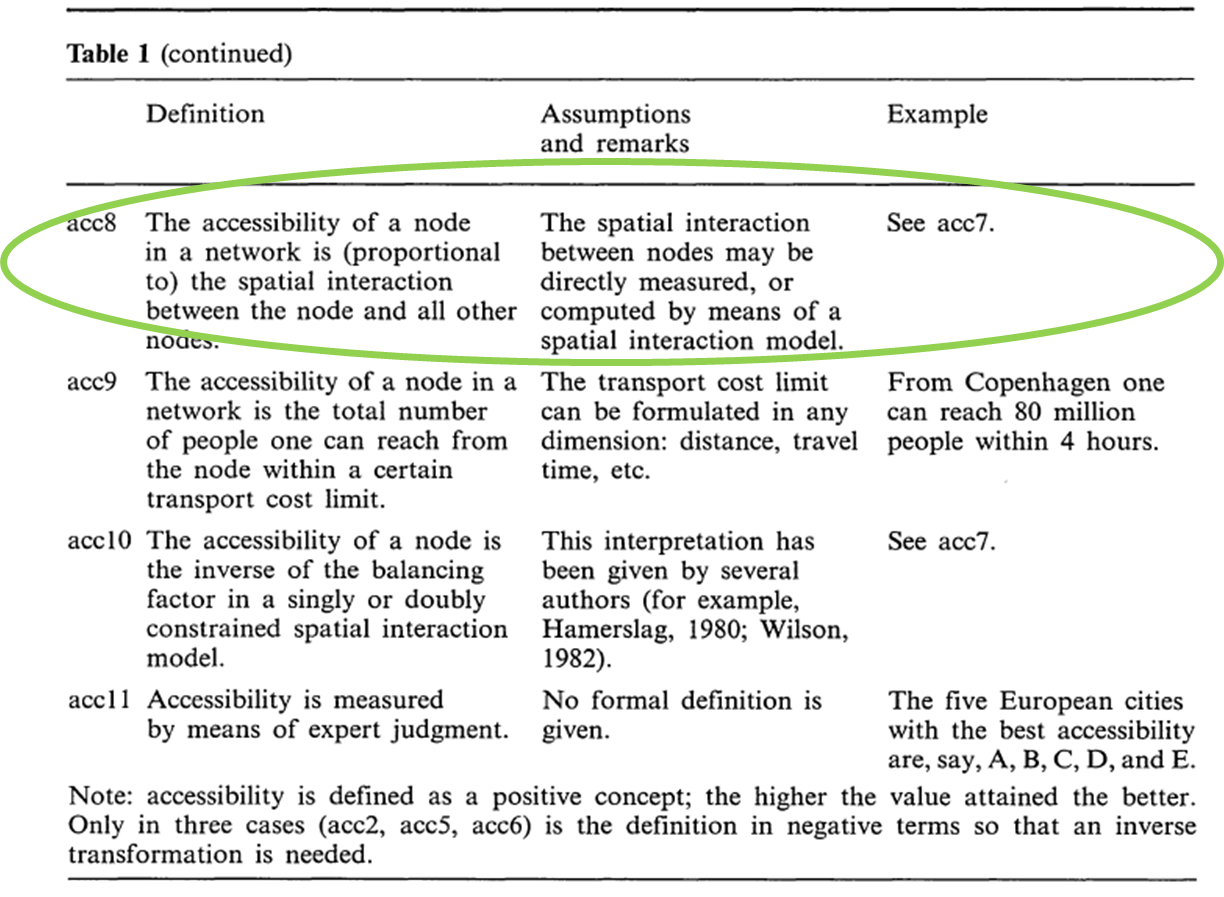
3. Estimate accessibility indicators
- \(Acc_{i} = \sum_j \frac{W_j}{d_{ij}^2}\)



3. Estimate accessibility indicators
Geographical indicator
Spatial structure (e.g. distance) and economic activities (e.g. population)
The potential for interaction
Opportunities
Not the only way to define accessibility on networks!
Discussion: What is accessibility to you?
Accessibility of locations from routing perspective

Accessibility of locations from routing perspective
Vrabková, Ertingerová, and Kukuliač (2021)
Vrabková, Ertingerová, and Kukuliač (2021)